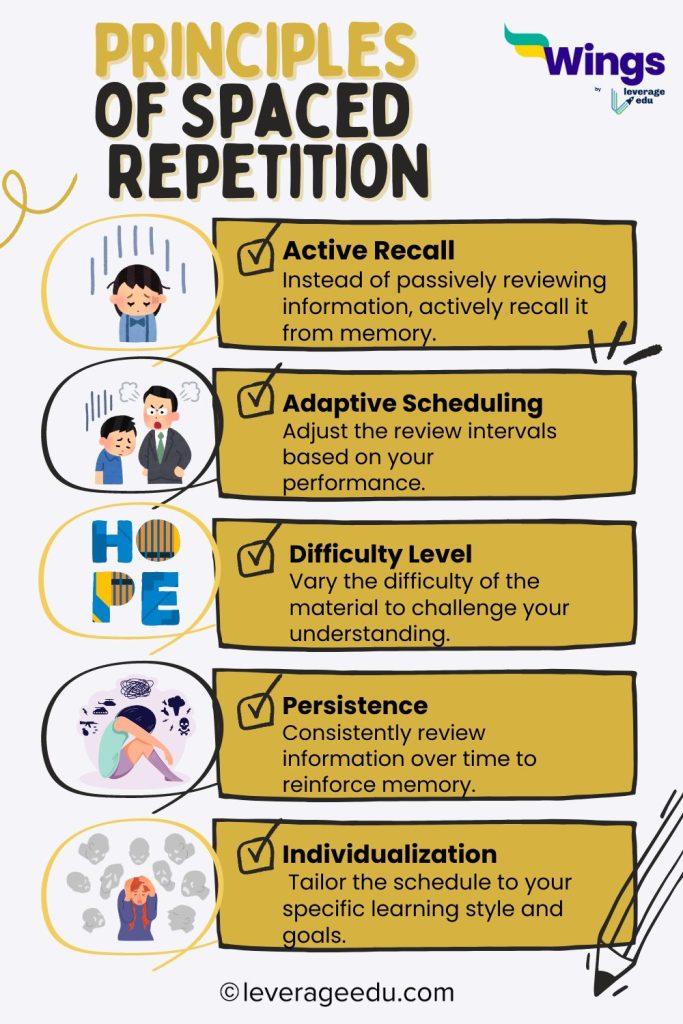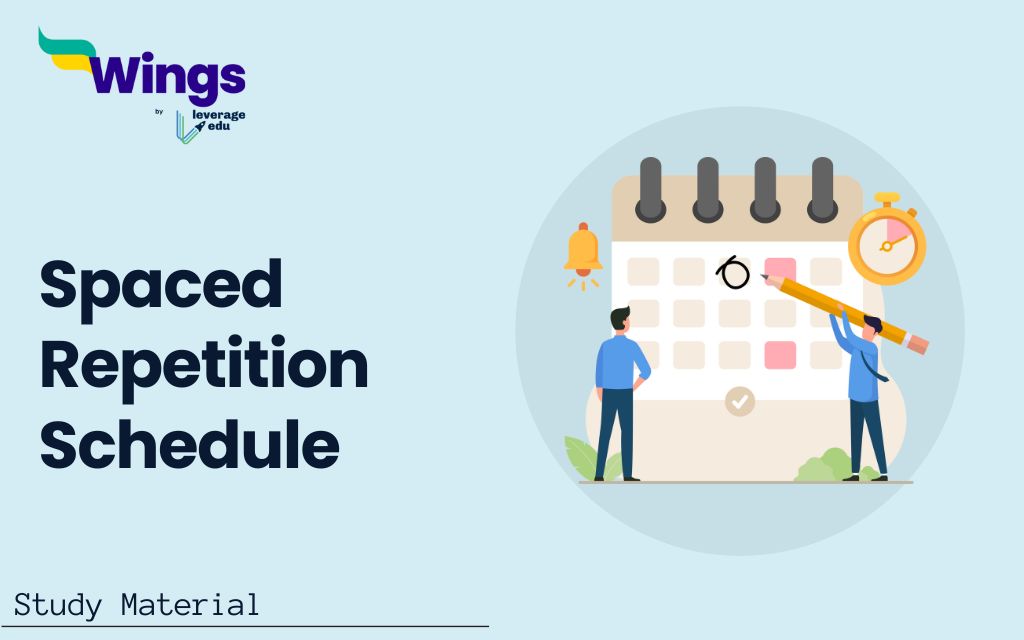Have you heard of the different learning techniques? These techniques help you learn information and knowledge more effectively. Today we will discuss one of these methods, the Spaced Repetition Schedule. It is a learning technique that improves the time intervals between reviewing material to improve retention. This strategy is based on the principle of forgetting curve. According to this theory, our memory decreases with time unless actively restored. As a result, this technique involves repeatedly revisiting study material over long periods of time. In this section, we will go over the Spaced Repetition Schedule in depth. This will help you adopt this strategy into your study habits.
Contents
- 1 What is Spaced Repetition Schedule?
- 2 Origins of Spaced Repetition Schedule
- 3 Principles of Spaced Repetition Schedule
- 4 Process of Spaced Repetition Schedule
- 5 Psychological Impact of Spaced Repetition Schedule
- 6 Application of Spaced Repetition Schedule
- 7 Different Methods of Spaced Repetition Schedule
- 8 Challenges of Spaced Repetition Schedule
- 9 Future of Spaced Repetition Schedule
- 10 FAQs
What is Spaced Repetition Schedule?
A spaced repetition schedule is a method of learning that restores the material at regular intervals. It is done to improve memory and knowledge retention. It is widely used in education, language learning and other fields that need long-term information retention. This strategy has a psychological impact, which leads to improved memory and attention.
Origins of Spaced Repetition Schedule
Spaced Repetition dates back to the 19th century and was introduced by the German psychologist Hermann Ebbinghaus. He developed the forgetting curve, which calculated his memory retention. He discovered that while information is forgotten at an increasing pace, reviewing it at regular intervals increases memory. This experiment laid the foundation for spaced repetition. This idea gained popularity in the 20th century, with the introduction of concepts such as Leitner’s Box Method in the 1970s and the SuperMemo algorithm in the 1980s.

Principles of Spaced Repetition Schedule
The primary idea behind spaced repetition is to schedule review sessions so that they happen just when you are about to forget about the topic. By doing so, you improve your memory after each interval. The concept is based on the spaced learning effect, which shows that material is more likely to be maintained when reviewed at regular intervals rather than in a single cramming session.

Also Read: Method Study – Meaning, Concept, and Scope
Process of Spaced Repetition Schedule
The technique of spaced repetition follows a specific process, which is described here. The system follows a non-linear pattern. Early assessments increase the chances of forgetting the material, but longer intervals between reviewing the study material improve memory.
This is an example of a spaced repetition schedule for learning any information:
- First review: Immediately after learning
- Second review: 2-3 days later
- Third review: 7 days after the second review
- Fourth review: 14 days after the third review
- Fifth review: 1 month after the fourth review
- Sixth review: 2-3 months later
- Seventh review: 6 months later
Psychological Impact of Spaced Repetition Schedule
The Spaced Repetition Method is effective because it has a psychological and cognitive impact on your brain. Some of the effects are discussed below.
- The Forgetting Curve: It describes how the brain tends to lose knowledge over time. Spaced repetition looks at study material before it is forgotten and improves memory.
- Active Recall: Instead of simply reviewing content, spaced repetition encourages active recall, which forces the learner to recover knowledge from memory.
Also Read: Leitner System: Best Way to Improve Your Memory
Application of Spaced Repetition Schedule
Spaced Repetition can be used in various fields that require long-term retention of huge amounts of information.
- Medical Education: Medical students commonly use spaced repetition to memorise large amounts of information, including medicine names, anatomical details and disease symptoms.
- Exam Preparation: Many students study for standardised tests, which require the use of spaced repetition to memorise important formulas, concepts and vocabulary over a long period of time.
- Language Learning: Spaced repetition is a method of memorising vocabulary and grammar rules in learning a language.
- General Knowledge: Spaced repetition can be used in any learning environment that requires long-term memory, such as learning historical dates or facts.
Different Methods of Spaced Repetition Schedule
There are different methods for implementing a spaced repetition schedule. Some of the methods are mentioned below.
- Manual Spaced Repetition: The Leitner Box System is one of the simplest ways to practise manual spaced repetition. This method uses flashcards, which are divided into different “boxes” based on how well the material is understood.
- Anki: Anki is a digital tool that uses an algorithm to calculate an ideal period to review each flashcard.
- SuperMemo: SuperMemo was the first program to use a spaced repetition algorithm, and it continues to be widely used today.
- Quizlet: Quizlet offers a spaced repetition mode for language learners and students in different fields.
Challenges of Spaced Repetition Schedule
Spaced repetition offers a number of challenges and limitations. Some of the challenges are listed below.
- Time commitment: Spaced repetition requires regular and ongoing effort to see the results.
- Monotomy: The repetitive nature of the system can become boring for some learners which can reduce the effectiveness of this technique.
- Customisation: Because different types of content require differed spacing intervals, learners can customise their schedule for each subject or topic.
Future of Spaced Repetition Schedule
The future of spaced repetition depends on advances in machine learning and artificial intelligence. Future Spaced Repetition Schedule tools may include more dynamic algorithms that manage schedules based on an individual’s memory patterns. In education, spaced repetition may become a part of digital curriculums made available to students worldwide.
Spaced repetition is an effective learning technique which is based on psychology. Learners can improve their memory retention by managing review sessions at regular intervals.
Related Posts
FAQs
Spaced repetition is a scientific method of learning in which you review information at more frequent intervals throughout time. According to this technique, material studied at appropriate intervals is more likely to be remembered over time.
Active recall is testing your knowledge rather than simply studying notes. Some active recall strategies include self-testing and closed-book exercise.
2357 is a revision technique in which you revise your notes on day one, take a second look on day two and day three and then revisit them on day five and day seven.
This was all about the “Spaced Repetition Schedule”. For more such informative blogs, check out our Study Material Section, or you can learn more about us by visiting our Indian exams page.
 One app for all your study abroad needs
One app for all your study abroad needs














